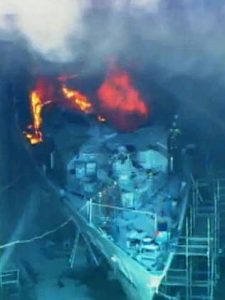- Author
- A.N. Other
- Subjects
- Ship histories and stories
- Tags
-
- RAN Ships
- HMAS Bundaberg
- Publication
- June 2015 edition of the Naval Historical Review (all rights reserved)
By John Jeremy
Thankfully it is a rare occurrence for the loss of a naval ship in peacetime but in this edition of the Review we report on the loss of the Armidale Class patrol boat HMAS Bundaberg following a major fire at Aluminium Boats Australia shipyard in Brisbane. This major incident appears to have gone almost unnoticed by the media.
In recent memory our navy has generally avoided accidental ship losses, other than that of the small ammunition ship HMAS Woomera which sank after a fire off the New South Wales coast in 1960, the tragic loss of HMAS Voyager following collision with HMAS Melbourne in 1964and, the patrol boat HMAS Arrow sunk on Christmas Day 1974 during Cyclone Tracy. But to this we must now add HMAS Bundaberg and attempt to explain the circumstances leading to her loss.
HMAS Bundaberg was an Armidale Class patrol boat designed and built by Austal at their yard at Henderson in Western Australia. The 56.8 m aluminium-alloy ship, one of fourteen built by Austal for the RAN, was commissioned on 3 March 2007.

In June 2014 Bundaberg began a refit by Aluminium Boats Australia Pty Ltd at Hemmant near Brisbane. On the morning of 11 August 2014 a fire broke out in the vessel whilst she was out of the water in a large covered building at the shipyard. The fire could not be contained by local fire-fighting equipment and rapidly spread throughout the ship. With the help of Queensland Fire and Emergency Services, who were called shortly before midday, the fire was not brought under control until late in the afternoon. No one was injured during the fire, which may have been caused by welding operations, but the ship and the shipyard was extensively damaged. Following a survey to determine if the ship could be repaired, Bundaberg was declared a constructive total loss. Bundaberg was formally decommissioned at a ceremony at her home port of Cairns on 18 December 2014. The fire has also resulted in the closure of the shipyard, which was forced into voluntary administration, with the loss of 160 jobs.
Whilst there has been no public statement to the effect that Bundaberg was a ‘constructive total loss’, that was clearly the effect of the survey. It is further understood the ship was totally insured for its replacement value in excess of $30m. The lack of an official statement about the loss probably stems from the complex web of responsibility for the ship at the time and the insurance implications.
The Armidales are known to have had a number of problems relating to maintenance but recently these appear to have been overcome. Bundaberg, in particular, previously had an onboard fire while undergoing maintenance in Darwin in 2011 which took the ship out of operation for several months.
However, this latest fire again raises the argument about the suitability of aluminium as a structural material for warship construction. In many cases aluminium has been preferred over steel as it results in reduced displacement and therefore improved operational efficiency, especially fuel consumption. Its disadvantage is the low melting point compared to steel with a potential increased risk from serious fire which must be minimised by improved insulation and fire protection systems as are widely employed today in high-speed aluminium craft.
When in dockyard hands internal ship fire protection systems may by necessity be isolated with reliance placed on other resources. While it is impossible to eliminate all accidents especially in such busy and confined spaces as ships in dock, experience warns us of the need for constant vigilance, to mitigate against such accidents. Great care must therefore be taken when welding operations are undertaken in ships in refit and strict precautions observed against possible causes of ignition. The loss of a warship and, seemingly the associated loss of a dockyard, is worthy of greater attention and exposure than this has so far received.




